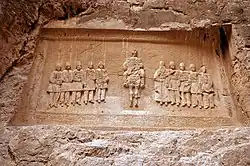Nassereddin Shah relief

The Nassereddin Shah relief known as Shekl Shah and Shekl-e Shah (Persian: شکل شاه) is a rock relief commissioned by Naser al-Din Shah Qajar around 1879, showing the shah on horseback flanked by ten standing ministers. It is the latest in a tradition of large rock reliefs ordered by Iranian rulers.[1] It is located on the Haraz road overlooking the Haraz river about 60 km from Amol in Mazandaran Province, Iran. It is close to an ancient Sassanid road.[2] The work was ordered after the new road was built in 1879.[3]
The relief is carved within a rectangular frame 8 m long and 4 m high. It carries an inscription in Persian poetic verses.[4] Russian soldiers used this relief for target practice during World War II.[5]
See also
References
- Sotudeh, M. 1995 (1374 AH). From Astara to Astarabad, vol. 3, western Mazandaran works and monuments
- ^ The last Iranian bas-relief: the depiction of Naser al-Din Shah Qajar on the Haraz road
- ^ "Shekl-e Shah in Larijan". Archived from the original on 2018-12-10. Retrieved 2017-02-22.
- ^ "ToIran, Shkl Shah". Archived from the original on 2017-02-23. Retrieved 2017-02-22.
- ^ Thinking Relatively on Nature Concept With Creating “Modern Tourism Space” At Mazandaran Through Tourism Approach
- ^ Itto, Shekl Shah
External links
![]() Media related to Shekl-e Shah at Wikimedia Commons
Media related to Shekl-e Shah at Wikimedia Commons